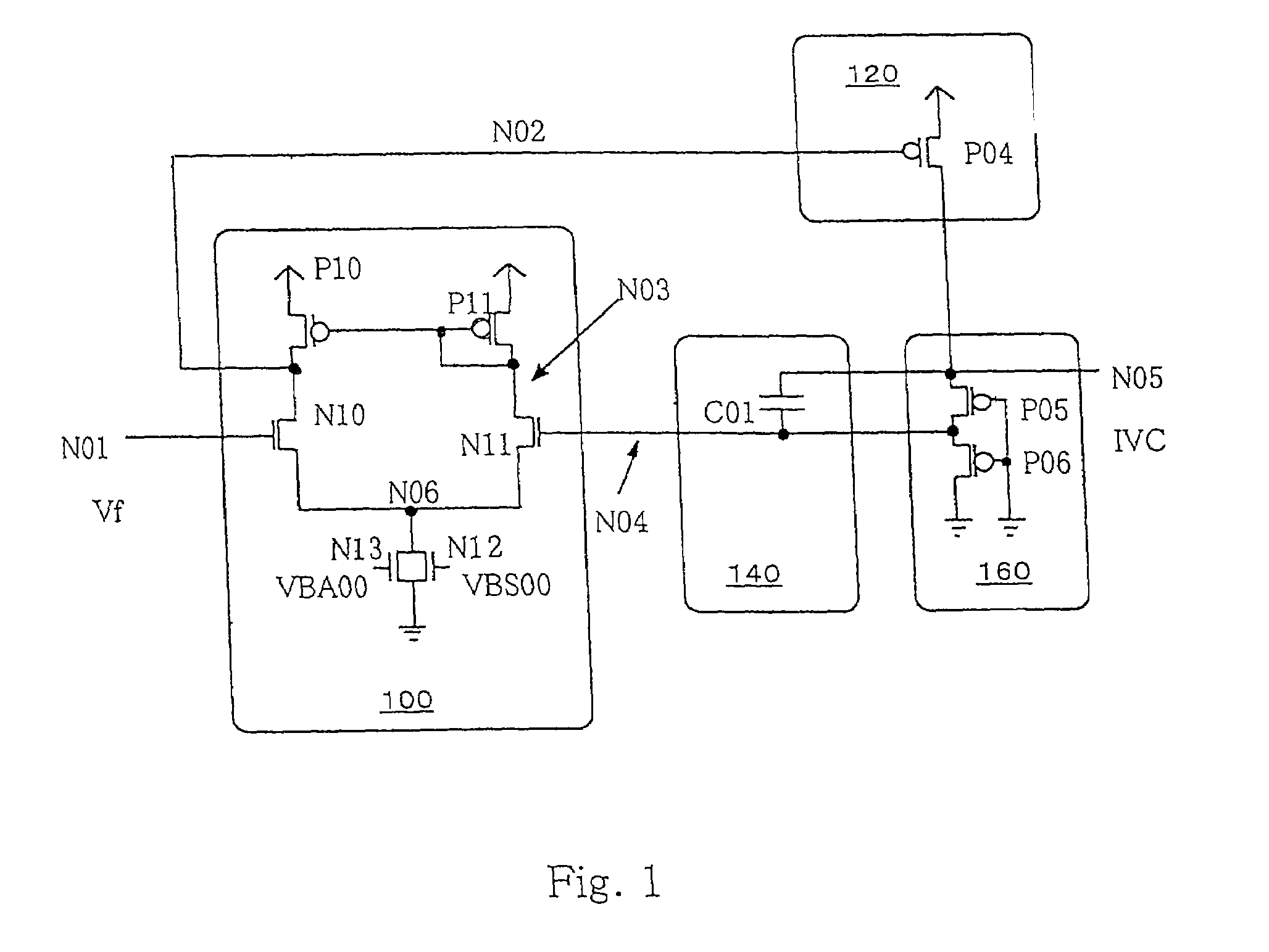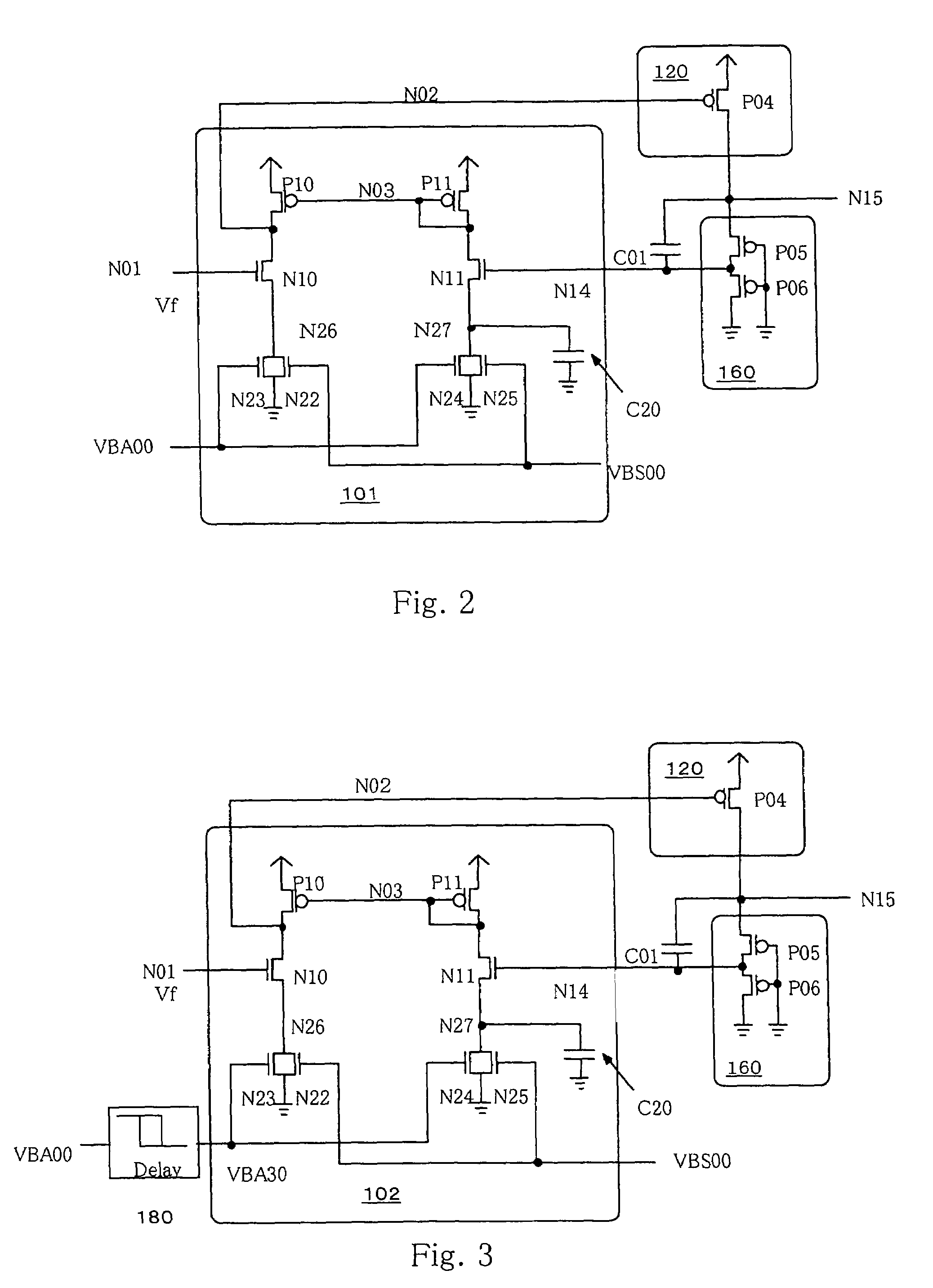Internal step-down power supply circuit
a power supply circuit and step-down technology, applied in the field of internal step-down power supply circuits, can solve the problems of inability to achieve compatibility with a follow-up to a change in internal step-down power supply potential, limited specs, etc., and achieve the effect of increasing current consumption and improving response performan
- Summary
- Abstract
- Description
- Claims
- Application Information
AI Technical Summary
Benefits of technology
Problems solved by technology
Method used
Image
Examples
first embodiment
[0018]FIG. 1 is a circuit diagram showing an internal step-down power supply circuit of the present invention. In the present specification unless otherwise stated below, VDD indicates an external source or power supply voltage, IVC indicates an internal source or power-supply voltage indicative of a potential level lower than the level of the external power supply voltage VDD, “H” indicates an external source or power supply voltage level, “L” indicates a ground level, “VF” indicates a reference potential, and “VB” indicates a current control voltage for a differential amplifier, respectively. Further, NMOSs are signs indicative of N channel MOS transistors, PMOSs are signs indicative of P channel MOS transistors, CAPs are signs indicative of capacitors, INVs are signs indicative of inverters, respectively.
[0019]The internal step-down power supply circuit shown in FIG. 1, according to the first embodiment of the present invention comprises a differential amplifier 100, a driver 120...
second embodiment
[0034]FIG. 2 is a circuit diagram showing an internal step-down power supply circuit according to the present invention. Incidentally, the same elements of structure as those in FIG. 1 are respectively identified by the same reference numerals in FIG. 2 and the description thereof will therefore be omitted.
[0035]Since the second embodiment is different from FIG. 1 in terms of a configuration of a differential amplifier 101, a description will be made of that portion alone.
[0036]The differential amplifier 101 comprises PMOSs P10 and P11, NMOSs N10, N11 and N22 through N25, and a stabilizing capacitor C20. In the differential amplifier 101, one electrode of the NMOS N10 is electrically connected to a node N02, the other electrode thereof is electrically connected to a node N26, and a gate electrode thereof is electrically connected to a node N01, respectively. One electrode of the NMOS N11 is electrically connected to a node N03, the other electrode thereof is electrically connected t...
third embodiment
[0044]FIG. 3 is a circuit diagram showing an internal step-down power supply circuit according to the present invention. Incidentally, the same components as those shown in FIG. 2 are respectively identified by the same reference numerals in FIG. 3, and the description thereof will therefore be omitted.
[0045]The third embodiment is different in timing provided to input the signal VBA00 shown in FIG. 3. Namely, the third embodiment is provided with a delay circuit 180 for delaying the differential amplifier 102 employed in the second embodiment from a standby state. Hence only portions associated with it will be described.
[0046]In a differential amplifier 102, gate electrodes of NMOSs N23 and N24 are respectively electrically connected to a node VBA30. The node VBA30 receives a signal VBA00 through the delay circuit 180 in such a manner that the signal VBA00 is delayed by a time required to completely bring an internal step-down power-supply slave circuit to the standby state upon on...
PUM
 Login to View More
Login to View More Abstract
Description
Claims
Application Information
 Login to View More
Login to View More - R&D
- Intellectual Property
- Life Sciences
- Materials
- Tech Scout
- Unparalleled Data Quality
- Higher Quality Content
- 60% Fewer Hallucinations
Browse by: Latest US Patents, China's latest patents, Technical Efficacy Thesaurus, Application Domain, Technology Topic, Popular Technical Reports.
© 2025 PatSnap. All rights reserved.Legal|Privacy policy|Modern Slavery Act Transparency Statement|Sitemap|About US| Contact US: help@patsnap.com



